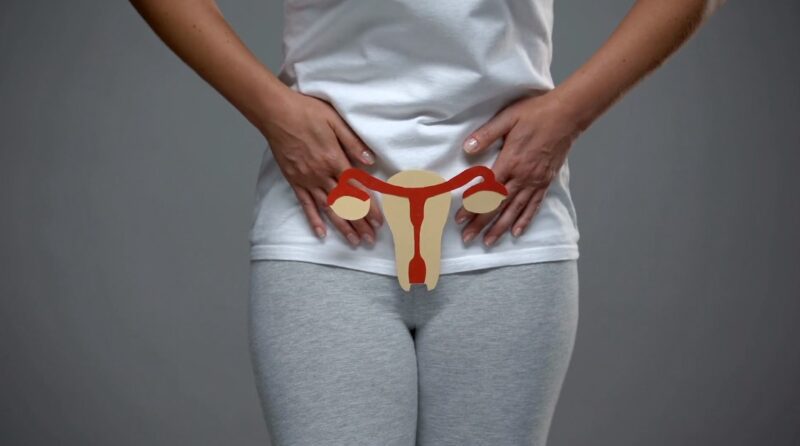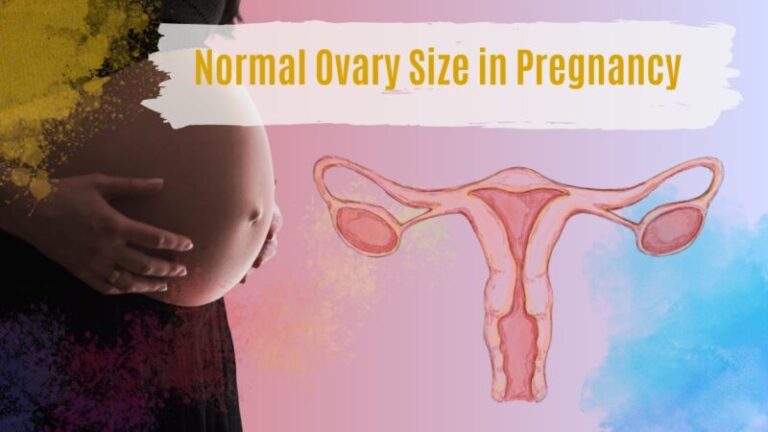The ovaries play a vital role in reproductive health, producing eggs for fertilization and releasing hormones that regulate the menstrual cycle. Any abnormalities in their size can potentially impact fertility.
Today we’ll explore the normal size of these organs, how it’s measured, and its impact on pregnancy. We’ll also talk about conditions that can affect this, such as PCOS and ovarian cysts, and discuss their implications for fertility and conception.
Ovarian Anatomy
The ovaries are two small, almond-shaped organs located on either side of the uterus in the female reproductive system. They play a crucial role in reproduction, producing eggs for fertilization and releasing hormones that regulate the menstrual cycle.
Each of them is typically about the size of a large almond, but size can vary from woman to woman and can change throughout a woman’s life. They contain thousands of follicles, which are tiny sacs that hold immature eggs.
Once a month, during ovulation, one of these follicles matures and releases an egg, which travels down the fallopian tube to potentially be fertilized. This process is regulated by a complex interplay of hormones, including follicle-stimulating hormone (FSH) and luteinizing hormone (LH), which are produced by the pituitary gland in the brain.
In addition to their role in ovulation, these organs also produce the hormones estrogen and progesterone. These hormones are essential for regulating the menstrual cycle, maintaining pregnancy, and supporting overall reproductive health.
Estrogen is responsible for the development and regulation of the female reproductive system and secondary sex characteristics, while progesterone prepares the uterus for pregnancy and maintains pregnancy.
How to measure it?

The size of the organs is typically measured using imaging techniques, such as ultrasound or laparoscopy. These methods allow healthcare providers to visualize the organs and take accurate measurements.
Ultrasound imaging
Ultrasound is the most common method used for measuring. This non-invasive procedure uses sound waves to create images of the ovaries, allowing a healthcare provider to assess their size, shape, and structure.
During an ultrasound, a small device called a transducer is moved across the abdomen or inserted into the vagina to create images of the organs. This allows the healthcare provider to measure their size and identify any abnormalities, such as cysts or tumors.
The measurements taken during an ultrasound can provide valuable information about a woman’s reproductive health and fertility.
Laparoscopy

On the other hand, this is a surgical procedure that involves inserting a small camera through a tiny incision in the abdomen. This provides a detailed view of the organs and other reproductive organs, allowing for precise measurements and the identification of any abnormalities.
While laparoscopy provides a more detailed view of the ovaries than ultrasound, it is a more invasive procedure and is typically reserved for situations where more detailed information is needed, or when other conditions are suspected.
Average Size
The average size of these organs in women of reproductive age is approximately 3.5 cm x 2.5 cm x 1.5 cm, or about the size of a large almond. However, their size can vary based on several factors, including age and hormonal changes.
During puberty, they grow and begin to produce eggs and hormones, leading to an increase in size. After menopause, the ovaries typically shrink, as they no longer produce eggs and the production of hormones decreases. It’s also worth noting that the size of the organs can fluctuate throughout the menstrual cycle.
During ovulation, they may enlarge slightly due to the growth of the follicles. This is a normal part of the ovulatory cycle and is not cause for concern.
Normal Ovary Size in Relation to Pregnancy

The size of these organs can impact fertility and pregnancy in several ways. First, they must be of adequate size to produce and release mature eggs for fertilization. If the ovaries are too small or underdeveloped, it may result in insufficient egg production, which can affect fertility.
Second, size can influence the production of hormones. These organs produce estrogen and progesterone, which are essential for regulating the menstrual cycle, supporting the implantation and growth of a fertilized egg, and maintaining pregnancy.
If they are not of adequate size, they may not produce sufficient levels of these hormones, which can lead to menstrual irregularities, difficulties with conception, or complications during pregnancy. Lastly, abnormalities, such as enlarged ovaries or ovarian cysts, can potentially interfere with ovulation, implantation, or the early stages of pregnancy.
Therefore, maintaining normal ovary size is crucial for optimal fertility and pregnancy outcomes. If you’re trying to conceive and have concerns about your ovary size or health, it’s important to discuss these with a healthcare provider. They can provide guidance and recommend appropriate tests or treatments.
Polycystic Ovary Syndrome (PCOS)
PCOS is a common condition characterized by enlarged organs with multiple small cysts. Women with PCOS often experience irregular menstrual cycles, excess hair growth, and difficulties with fertility. This is one of the most common hormonal disorders in women of reproductive age, affecting approximately 5-10% of this population.
This syndrome can affect fertility and pregnancy in several ways. The hormonal imbalances associated with PCOS can interfere with ovulation, making it difficult to conceive. Additionally, women with this syndrome are at a higher risk of complications during pregnancy, such as gestational diabetes and preterm birth.
An important aspect to consider with PCOS is the thickness of the endometrium, which can be influenced by this condition and can further impact fertility.
Treatment for this condition often involves lifestyle modifications, such as diet and exercise, and medications to regulate the menstrual cycle and improve fertility. These treatments aim to manage the symptoms of PCOS, regulate the menstrual cycle, and improve fertility.
Cysts and Pregnancy
Ovarian cysts are fluid-filled sacs that develop on the organs. While most cysts are harmless and resolve on their own, some can grow large, cause pain, and potentially impact fertility and pregnancy. There are several types of cysts, including functional cysts, dermoid cysts, cystadenomas, and endometriomas.
Functional cysts, which form during the menstrual cycle, are the most common type of ovarian cyst. These cysts typically don’t affect fertility and often resolve on their own within a few menstrual cycles.
However, other types of cysts, such as endometriomas or cystadenomas, can interfere with ovulation, affect the quality of the eggs, or cause complications during pregnancy. In some cases, surgery may be recommended to remove the cysts.
This decision must be carefully weighed against the potential risks of surgery, including damage to the organs and potential impacts on future fertility.
Ovulation

The size and health of the ovaries can influence the process of ovulation. Organs that are of normal size and function are more likely to produce and release mature eggs for fertilization. This process, known as ovulation, is crucial for fertility and is regulated by a complex interplay of hormones.
Conditions that affect ovary size, such as PCOS or cysts, can interfere with ovulation. For example, women with PCOS often experience irregular ovulation or anovulation (lack of ovulation), which can make it difficult to conceive. Similarly, large cysts can disrupt the normal functioning of the organs and interfere with ovulation.
Monitoring the size and function of the organs can provide valuable insights into ovulation patterns and fertility. This can be done through regular gynecological exams, imaging tests, and tracking menstrual cycles.
Egg Quality
The size and health of the organs can also affect the quality of the eggs produced. Healthy ovaries are more likely to produce high-quality eggs, which are more likely to be successfully fertilized and result in a healthy pregnancy. Egg quality refers to the genetic health of an egg, which is crucial for the development of a healthy embryo.
Poor egg quality can increase the risk of miscarriage and genetic abnormalities in the fetus. It can also make it more difficult to conceive, particularly for women who are older or who are undergoing fertility treatments. If you’re trying to conceive and are concerned about your egg quality, it’s important to discuss your concerns with a healthcare provider.
They can provide guidance and recommend tests or treatments to optimize your fertility. This may include lifestyle modifications, such as diet and exercise, as well as medical treatments, such as fertility medications or assisted reproductive technologies (ART).
Monitoring Ovary Size during Pregnancy

During pregnancy, the ovaries undergo several changes. In the early stages of pregnancy, they produce hormones that support the growth and development of the fetus. They also contain the corpus luteum, a structure that produces progesterone until the placenta takes over this function around the 10th to 12th week of pregnancy.
Monitoring their size during pregnancy can help identify potential complications or abnormalities. For example, an enlarged ovary or the presence of cysts during pregnancy can increase the risk of ovarian torsion
Ovarian Torsion
Ovarian torsion is a condition characterized by the twisting of an ovary, which can cut off its blood supply. This can cause severe pain and, if not treated promptly, can lead to the loss of the organ. Pregnancy increases the risk of ovarian torsion, due to the changes in the size and position of the organs.
Other risk factors include cysts, ovarian hyperstimulation syndrome (a condition caused by fertility treatments), and certain surgical procedures. Symptoms of this condition include sudden, severe pelvic pain, nausea, and vomiting.
If you’re pregnant and experience these symptoms, it’s important to seek immediate medical attention. This is a medical emergency that requires prompt treatment to preserve the organ. Treatment typically involves surgery to untwist the organ and restore its blood supply. In some cases, if it is severely damaged, it may need to be removed.
Treatment Options

If your ovaries are abnormally sized due to a certain condition there are several treatment options available. The right treatment for you will depend on the underlying cause, your symptoms, and your fertility goals.
Treatment options can include hormonal therapies to regulate the menstrual cycle and improve ovulation, surgical procedures to remove cysts or correct ovarian torsion, and lifestyle modifications to manage symptoms and improve overall health.
Hormonal therapies, such as birth control pills or fertility medications, can help regulate the menstrual cycle, improve ovulation, and manage symptoms of conditions like PCOS. Surgical procedures, such as cystectomy (removal of cysts) or oophorectomy (removal of the ovaries), may be necessary in some cases.
However, these procedures are typically reserved for situations where other treatments have been unsuccessful, or when the condition is severe. Lifestyle modifications, such as maintaining a healthy weight, eating a balanced diet, and getting regular exercise, can also help manage symptoms and improve overall reproductive health.
FAQs:
Can ovary size impact the success of assisted reproductive technologies (ART) such as in vitro fertilization (IVF)?
Yes, it can influence the response to fertility treatments like IVF. It may affect the number of eggs retrieved and the overall success rate of the procedure.
Can stress or emotional factors affect this?
While stress and emotional factors can affect overall reproductive health, their direct impact on this aspect is not well-established. However, managing stress is important for overall well-being and fertility.
Is there a chance that one ovary differs from the other?
Yes, in fact it is common. However, significant differences may warrant further investigation.
Is it possible to increase them naturally through lifestyle changes or dietary interventions?
There are no specific lifestyle changes or dietary interventions known to directly increase ovary size. However, maintaining overall good health, a balanced diet, and regular exercise can support reproductive well-being.
Are there any specific symptoms that may indicate abnormalities?
Symptoms such as irregular menstrual cycles, persistent pelvic pain, unusually heavy or light periods, or difficulty conceiving may indicate potential issues with ovary size or function.
Conclusion
It is crucial for women of reproductive age to understand the normal size of ovaries and its impact on pregnancy. While a certain range is considered normal, significant deviations can indicate potential health issues that may affect fertility and pregnancy.
If you have concerns about your ovary size or health, it’s important to seek medical advice. A healthcare professional can assess your organs, provide a diagnosis, and recommend appropriate treatments to optimize your fertility and reproductive health.
Remember, every woman is unique, and what’s normal for one person may not be for another. Always seek individualized medical advice when it comes to your reproductive health. Your health and well-being are important, and understanding your body is a key part of maintaining your overall health.
Related Posts:
- Normal Endometrial Thickness in Periods and…
- Hollywood’s Most Well-Endowed Celebs - Size Matters!…
- What Does 'In Transit' Mean and Tips for Estimating…
- How Long Does CBD Oil Stay in Your System? 2024 Tips…
- When Does ‘Bachelor in Paradise’ Season 4 Premiere? (UPDATE)
- How Long Does Vaping CBD Stay in Your System?…











